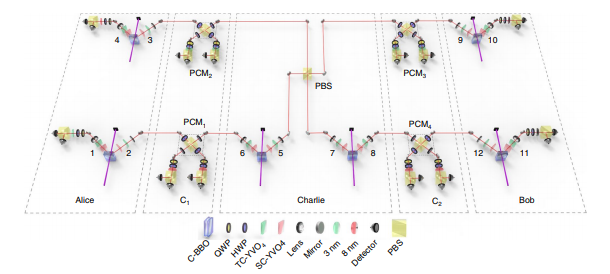Quantum repeaters, as the important components of a scalable quantum internet, enable the distribution of quantum states over long distances. The standard paradigm for a quantum repeater consists of three basic technologies: entanglement swapping, entanglement purification and quantum memory. However, the limited performance of current quantum memories remains a major obstacle in realizing practical quantum repeaters.
Recently, the research team led by Prof. PAN Jianwei, Prof. CHEN Yuao and Prof. XU Feihu from the University of Science and Technology of China (USTC), has demonstrated the all-photonic quantum repeater which eliminates the need for matter quantum memories, thus offering a new approachto construct thelong-distance optical quantum internet. The research was published in Nature Photonics on June 24th.
In the research, the experiment adopted a GHZ state and a passive scheme to realize the selective Bell measurement in the repeaternodes. By manipulating a 12-photon interferometer,the team implemented a 2×2 parallel all-photonic quantum repeater, and observed an 89% enhancement of entanglement-generation rate over standard parallel entanglement swapping.

Fig 1: Experimental set-up. (Image by PAN Jianwei’s team)
These results provide a new approach to design quantum repeaters with efficient single-photon sources and photonic graph states, and suggest that the all-photonic scheme represents analternative pathtowards realizing practical quantum repeaters.
In the future, the research team is devoted tocombine the all-photonic schemewith the matter-memory-based scheme: therepeater graph state (RGS) can relax the requirement of long coherent time of quantum memory, while a quantum memory can reduce the requirement of large size for the RGS. Overall, all-photonic and matter-memory-based schemes are two important parallel research directions towards achieving a practical quantum repeater.
The successful demonstration of all-photonic quantum repeater suggests that the quantum memory is no longer a necessary condition for building a quantum repeater, which opens up a new way for the research on long-distance quantum communications and networks.
Paper link:
https://doi.org/10.1038/s41566-019-0468-5
(Written by LI Xiaoxi, edited by LI Xiaoxi, USTC news center)